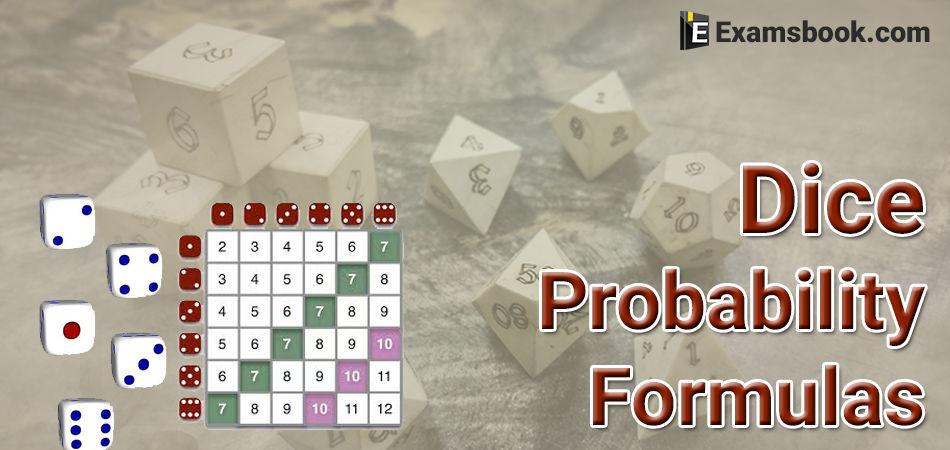Dice Probability Formulas for Competitive Exams

Formulas of Dice Probability Questions
Example.3. Two dice are thrown simultaneously. Find the probability of:
(a) Getting sum of at least 11
Solution:
Two different dice are thrown simultaneously being number 1, 2, 3, 4, 5 and 6 on their faces. We know that in a single thrown of two different dice, the total number of possible outcomes is (6 × 6) = 36
getting sum of atleast 11:
Let E7 = event of getting sum of atleast 11. The events of the sum of atleast 11 will be E7 = [(5, 6), (6, 5), (6, 6)] = 3
Therefore, probability of getting ‘sum of atleast 11’
$$P(E) ={Number \ of \ favorable \ outcomes\over Total \ number \ of \ possible \ outcome }$$
= 3/36
= 1/12
(b) getting an even number as the sum
Solution:
Two different dice are thrown simultaneously being number 1, 2, 3, 4, 5 and 6 on their faces. We know that in a single thrown of two different dice, the total number of possible outcomes is (6 × 6) = 36
getting an even number as the sum:
Let E10 = event of getting an even number as the sum. The events of an even number as the sum will be E10 = [(1, 1), (1, 3), (1, 5), (2, 2), (2, 4), (2, 6), (3, 3), (3, 1), (3, 5), (4, 4), (4, 2), (4, 6), (5, 1), (5, 3), (5, 5), (6, 2), (6, 4), (6, 6)] = 18
Therefore, probability of getting ‘an even number as the sum
$$P(E) ={Number \ of \ favorable \ outcomes\over Total \ number \ of \ possible \ outcome }$$
= 18/36
= 1/2
Example.4. Two dice are thrown.
Find (a) the odds in favour of getting the sum 5
Solution:
We know that in a single thrown of two die, the total number of possible outcomes is (6 × 6) = 36.
Let S be the sample space. Then, n(S) = 36.
Let E1 be the event of getting the sum 5. Then,
E1 = {(1, 4), (2, 3), (3, 2), (4, 1)}
⇒ P(E1) = 4
Therefore, P(E1) = n(E1)/n(S) = 4/36 = 1/9
⇒ odds in favour of E1 = P(E1)/[1 – P(E1)] = (1/9)/(1 – 1/9) = 1/8.
Find (b) the odds against getting the sum 6.
Solution:
We know that in a single thrown of two die, the total number of possible outcomes is (6 × 6) = 36.
Let S be the sample space. Then, n(S) = 36.
Let E2 be the event of getting the sum 6. Then,
E2 = {(1, 5), (2, 4), (3, 3), (4, 2), (5, 1)}
⇒ P(E2) = 5
Therefore, P(E2) = n(E2)/n(S) = 5/36
⇒ odds against E2 = [1 – P(E2)]/P(E2) = (1 – 5/36)/(5/36) = 31/5.
Probability for Rolling Three Dice
Probability for rolling three dice with the six sided dots such as 1, 2, 3, 4, 5 and 6 dots in each (three) dies.
When three dice are thrown simultaneously/randomly, thus number of event can be 63 = (6 × 6 × 6) = 216 because each die has 1 to 6 number on its faces.
Example: Three dice are thrown together. Find the probability of:
(a) Getting a total of 6.
Solution:
Three different dice are thrown at the same time.
Therefore, total number of possible outcomes will be 63 = (6 × 6 × 6) = 216.
getting a total of 6:
Number of events of getting a total of 6 = 10
i.e. (1, 1, 4), (1, 4, 1), (4, 1, 1), (1, 2, 3), (1, 3, 2), (2, 1, 3), (2, 3, 1), (3, 1, 2), (3, 2, 1) and (2, 2, 2).
Therefore, probability of getting a total of 6
$$P(E) ={Number \ of \ favorable \ outcomes\over Total \ number \ of \ possible \ outcome }$$
= 10/216
= 5/108.
(b) Getting a total of 5.
Solution:
Three different dice are thrown at the same time.
Therefore, total number of possible outcomes will be 63 = (6 × 6 × 6) = 216.
getting a total of 5:
Number of events of getting a total of 5 = 6
i.e. (1, 1, 3), (1, 3, 1), (3, 1, 1), (2, 2, 1), (2, 1, 2) and (1, 2, 2)
Therefore, probability of getting a total of 5
$$P(E) ={Number \ of \ favorable \ outcomes\over Total \ number \ of \ possible \ outcome }$$
= 6/216
= 1/36
You can ask me anything related dice probability formulas in the comment section without any hesitation.



